Yellow-naped Amazons: Conservation Partnerships
In June 2023, the World Parrot Trust, in collaboration with Finca La Gracia (The Lost Tinamou), brought together dedicated partners from across Central America to Guatemala for an informative four-day workshop hosted at Instituto Técnico de Capacitación y Productividad (INTECAP). The proceedings served as a platform for participants to exchange knowledge, explore practical field techniques and share successes and challenges in protecting Yellow-naped Amazons (Amazona auropalliata) across the species’ range.
Activities included instruction in climbing, where participants enhanced their skills and tackled challenging scenarios. Members also explored the critical role of roost monitoring in protecting parrot populations and highlighted effective techniques for data collection. Attendees were encouraged to present their ongoing work, discuss the habitats they work in and engage in other important discussions. The event was a combined alliance-building and practical workshop that will help further Yellow-naped Amazon conservation across the region.
IUCN/CITES Status: Critically Endangered / Appendix I
Population: About 2400 individuals, decreasing.
Threats: This species is seriously threatened by habitat loss and degradation driven primarily by the expansion of agriculture, and capture for local and international wild bird trade.
Range: A.a. auropalliata: Pacific slope from Oaxaca, Mexico to NW Costa Rica A.a. parvipes: Mosquitia of Honduras and NE Nicaragua A.a. caribaea: Bay Islands, Honduras
Natural history: The Yellow-naped Amazon favours deciduous forest, pine-oak woodland, gallery forest along waterways, arid to semi-arid savanna woodland, and dry scrubland with remnant woodlots or scattered trees. Birds are found in pairs or flocks with larger gatherings at communal roosts and feed areas. It feeds on seeds, figs and ripening Terminalia fruits. Bay Island birds feed on pine cones.

